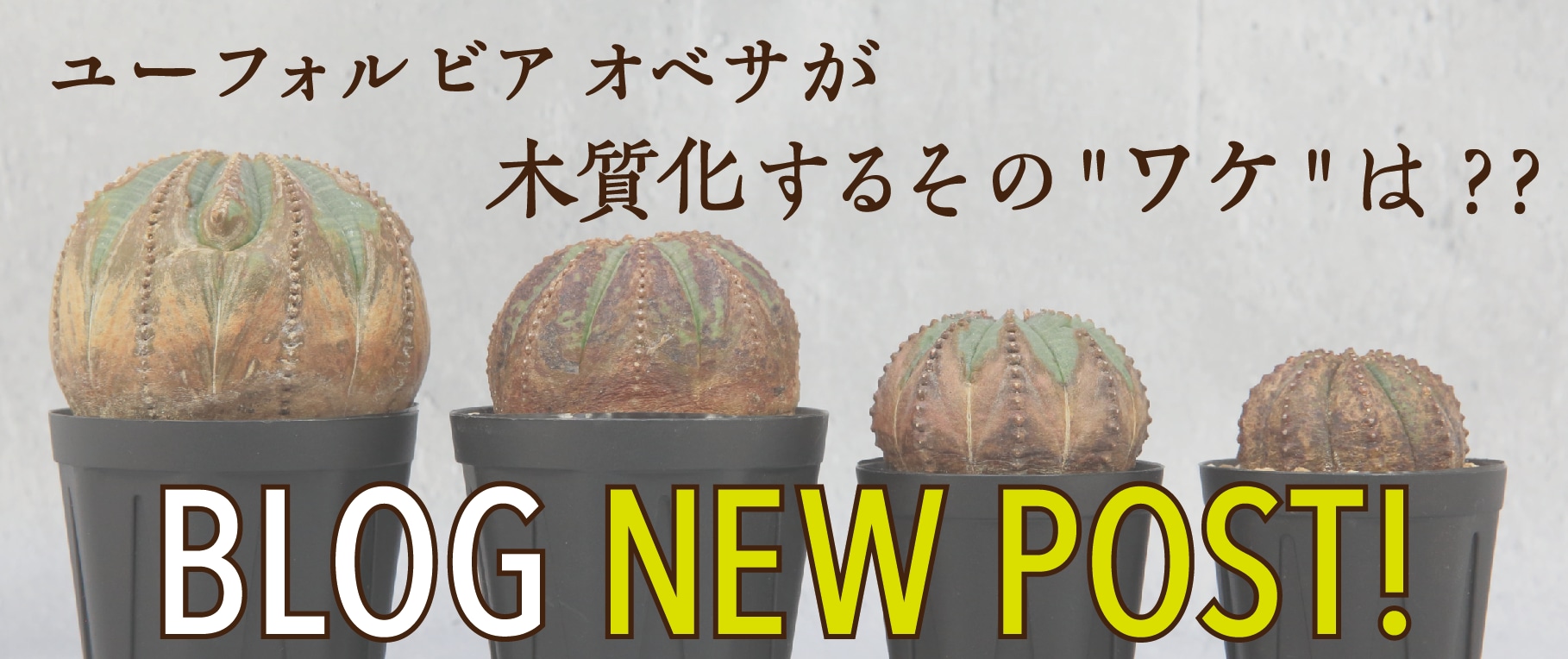BLOG
2022/01/09 12:33

木質化には様々な要因があり、諸説紛紛です。
Why does OBESA do lignification?
※あくまでLIGHTHOUSE PLANTS独自の見解であり学術的根拠はございませんので悪しからず。
Lighthouse Plantsが考えるユーフォルビア オベサが木質化する理由は「自分の身を守るため」。
だと考えます。
木質化するのはオールドユーフォルビアだけ?
おそらく木質化は、オールドユーフォルビア オベサなどの長く生きているユーフォルビア オベサに起こりやすい症状だと思われているのでは無いでしょうか?
もちろんそれも間違いではありませんが、逆に若い小さなユーフォルビア オベサが木質化しないのかと言えば答えは”NO”です。
There are many reasons for lignification.
*This is LIGHTHOUSE PLANTS own opinion and has no academic basis.
“ lignification meaning "
The process of turning into wood or becoming woodlike.
In this blog, We often call it Woody or Wood conversion .
That's the same thing as lignification.
We believe that the reason why OBESA becomes woody is to "protect itself”.
Is the wood conversion only for Old OBESA?
We say NO, young OBESA can also be lignified.
The reason for this is the environment.
若いユーフォルビア オベサも木質化します。
では、どのような条件で木質化するのか。
それは「環境」にあります。
気温と水分が木質化の鍵を握る
天候、気温、水分、湿度、日光などなど。
これらの環境がユーフォルビア オベサにとって過酷であればあるほど木質化しやすい傾向にあり、中でも気温と水分が木質化の鍵を握ります。
Lighthouse Plantsのユーフォルビア オベサを見ていただければ一目瞭然ですが、小さかろうが大きかろうが、ヤングであろうがオールドであろうが。
関係なく木質化しています。
となると、寒暖差が大きく影響していることがおわかりいただけるかと思います。
Young and small OBESA will also be lignified.
It depends on the environment.
Temperature and moisture are important reasons for lignification.
Cold temperature differences are a major cause of lignification.
I’d like you to take a look at LIGHTHOUSE's OBESA.
If you do, you will find the answer..
Of course, there are many other reasons.
(Weather, Temperature, Moisture, Humidity, Sunlight..,etc,)
It doesn't matter if you're “Young OBESA or Old OBESA."
育つ環境が及ぼす結果
友人のナーサリーがあるヨーロッパの地域・気候について、
その場所がオベサ育成・栽培に最適かといえばそうではないかもしれません。
しかしその環境はユーフォルビア オベサをより強く成長させます。
その一つの結果が木質化であり
それは「順応力」なのだとLIGHTHOUSE PLANTSは捉えています。
The consequences of the environment in which OBESA grows.
We don't think that the climate of the European Nursery is ideal for growing OBESA.
But it will make OBESA grow stronger.
We believe that one result of this is the shift to lignification.
It is the "adaptability of OBESA”
夏にも強く、冬にはもっと強い。
サボテンは原産地が主に南北アメリカ大陸ですが、多肉植物などのユーフォルビアは原産地がアフリカ大陸が主です。
前者は乾燥した高地で比較的涼しい所に自生しており、後者は乾燥した暖かい環境に多く自生しています。
一般的なユーフォルビア オベサは乾燥や暑さには非常に強いですが冬の寒さは少し苦手という印象をうけます。
しかし、Lighthouse Plantsのユーフォルビア オベサは夏に強いのはもちろん、冬にはもっと強いのが特徴です。
それは栽培環境・気候が大きく関与しているのは間違いないでしょう。
LIGHTHOUSE's OBESA is
"More resistant to heat in summer, more resistant to cold in winter! “
More adaptable than OBESA grown in a normal environment.
for reference...
(OBESA main habitat : South Africa / Dry and warm)
(CACTUS main habitat : North and South American / Dry highlands, Relatively cool environment)
LIGHTHOUSE's OBESA is a strong breed that can handle a variety of environments.
This is due in large part to the environment in which the seedlings are grown.
ツルッとしたのが好きなら国内実生株
Lighthouse Plantsのユーフォルビア オベサとは対照的な環境で育つ国内実生株と結果として”ツルッ”ときれいな肌感に育ちます。
かわいいですよね!これが国内実生株のいい所です。
しかしLighthouse Plantsのユーフォルビア オベサのような木質化をした国内実生株は見たことがありません。
国内の寒暖差くらいであれば心地よく成長しちゃう!
それに対してヨーロッパの”とある地域”の過酷な環境で育っているLighthouse Plantsのユーフォルビア オベサは、
寒暖差に強く、小さかろうが大きかろうが、ヤングであろうがオールドであろうが、身を守るために木質化しやすいのです。
そして国内の寒暖差くらいであれば心地よく成長しちゃう!
それがLighthouse Plantsのユーフォルビア オベサなのです。
Japanese seedlings OBESA is round and smooth.it's a big part of Japanese OBESA's character and charm.
European seedlings LIGHTHOUSE's OBESA is completely different.
It is woody, whether young or old, and is resistant to cold temperatures.
Isn't it amazing?
もちろん好き嫌いがあると思います。
是非あなたに合った雰囲気のユーフォルビア オベサを見つけてください。
We hope you will find the right Euphorbia obesa for you !!
【ユーフォルビア オベサ 木質化 全株】はこちらからご覧いただけます。
↓ ↓ ↓
↓ ↓ ↓
■ 公式Instagram

@lighthouse.plants

@lighthouseplants




